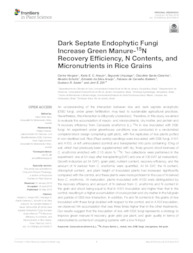Dark septate endophytic fungi increase green manure-15N recovery efficiency, N contents, and micronutrients in rice grains.
Dark septate endophytic fungi increase green manure-15N recovery efficiency, N contents, and micronutrients in rice grains.
Author(s): VERGARA, C.; ARAUJO, K. E. C.; URQUIAGA, S.; SANTA-CATARINA, C.; SCHULTZ, N.; ARAUJO, E. da S.; BALIEIRO, F. de C.; XAVIER, G. R.; ZILLI, J. E.
Summary: An understanding of the interaction between rice and dark septate endophytic (DSE) fungi, under green fertilization, may lead to sustainable agricultural practices. Nevertheless, this interaction is still poorly understood. Therefore, in this study, we aimed to evaluate the accumulation of macro- and micronutrients, dry matter, and protein and N recovery efficiency from Canavalia ensiformis (L.)-15N in rice inoculated with DSE fungi. An experiment under greenhouse conditions was conducted in a randomized complete block design comprising split-plots, with five replicates of rice plants potted in non-sterilized soil. Rice (Piauí variety) seedlings were inoculated with DSE fungi, A101 and A103, or left uninoculated (control) and transplanted into pots containing 12 kg of soil, which had previously been supplemented with dry, finely ground shoot biomass of C. ensiformis enriched with 2.15 atom % 15N. Two collections were performed in the experiment: one at 54 days after transplanting (DAT) and one at 130 DAT (at maturation). Growth indicators (at 54 DAT), grain yield, nutrient content, recovery efficiency, and the amount of N derived from C. ensiformis were quantified. At 54 DAT, the N content, chlorophyll content, and plant height of inoculated plants had increased significantly compared with the control, and these plants were more proficient in the use of N derived from C. ensiformis. At maturation, plants inoculated with A103 were distinguished by the recovery efficiency and amount of N derived from C. ensiformis and N content in the grain and shoot being equal to that in A101 inoculation and higher than that in the control, resulting in a higher accumulation of crude protein and dry matter in the full grain and panicle of DSE-rice interaction. In addition, Fe and Ni contents in the grains of rice inoculated with these fungi doubled with respect to the control, and in A103 inoculation, we observed Mn accumulation that was three times higher than in the other treatments. Our results suggest that the inoculation of rice with DSE fungi represents a strategy to improve green manure-N recovery, grain yield per plant, and grain quality in terms of micronutrients contents in cropping systems with a low N input.
Publication year: 2018
Types of publication: Journal article
Unit: Embrapa Soils
Observation
Some of Embrapa's publications are published as ePub files. To read them, use or download one of the following free software options to your computer or mobile device. Android: Google Play Books; IOS: iBooks; Windows and Linux: Calibre.
Access other publications
Access the Agricultural Research Database (BDPA) to consult Embrapa's full library collection and records.
Visit Embrapa Bookstore to purchase books and other publications sold by Embrapa.

